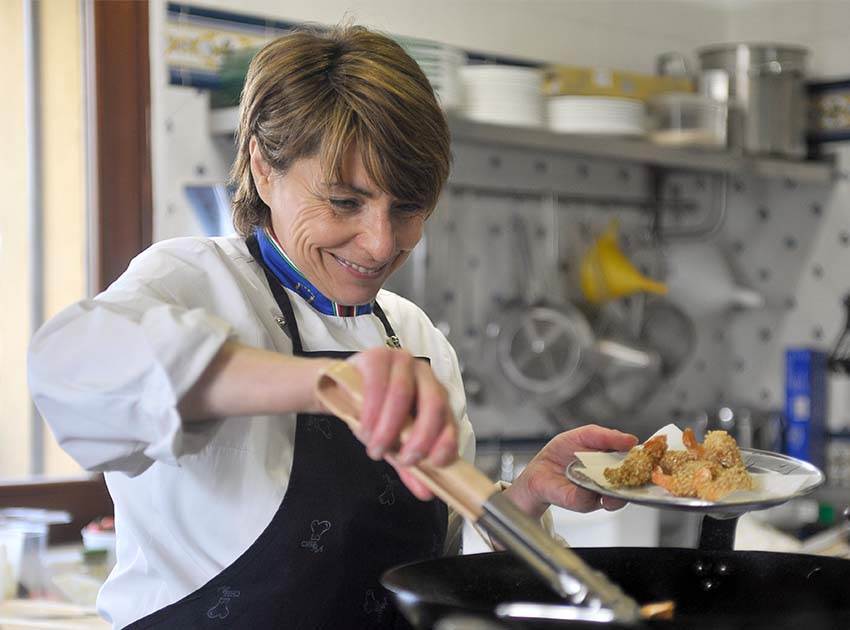Caserta, Naples and the wonders of Campania
Places narrated by Touring Club Italiano
If you say Caserta, you say Royal Palace, a UNESCO World Heritage Site. One of the most sumptuous residences of the Peninsula, it reflects Charles of Bourbon’s ambition and Vanvitelli’s great skills; it is an immense complex that turns the idea of space upside down and changes one’s perspectives; a place where monumentality and 18th century splendour of the royal residence combine with the romanticism of the park and gardens, which are so vast that one can hardly see their end.

If you say Caserta, you say Royal Palace one of the most sumptuous residences of the Peninsula, it reflects Charles of Bourbon’s ambition and Vanvitelli’s great skills; it is an immense complex that turns the idea of space upside down and changes one’s perspectives; a place where monumentality and 18th century splendour of the royal residence combine with the romanticism of the park and gardens, which are so vast that one can hardly see their end. Knowledgeably, this is where people want to go, when visiting Caserta. Yet there is more around the Reggia. There is the light-hearted spirit of Via Mazzini, the artery where one can find most of the clubs and restaurants of the modern city. There are the medieval masterpieces of Casertavecchia, the original nucleus of today’s Caserta, an enchanted village that Pasolini chose in 1971 to shoot some scenes of his film, The Decameron.
There is the industrial (and utopian) archaeology of San Leucio, a sort of ideal citadel that revolved around the royal silk factory commissioned by Ferdinand IV of Bourbon, who probably invented Italy’s first corporate welfare on that occasion. For the workers he provided decent housing, social security systems, guaranteed schools for their children, and no gender gap. There are also the archaeological remains of Santa Maria Capua Vetere, testifying to Campania’s extraordinary past. Which is extraordinary everywhere: it’s a region so radiant that makes one forget some of its shadows and issues.

Napul'è (Naples is)
Naples is a bit like a merry-go-round spinning at very high speed. It takes a day to adapt to its rhythms and a lifetime to forget all its charm. On the other hand, as locals use to say, “see Naples and then you can die”, because your eyes are totally filled with beauty. One must be prepared to leave a “piezz ‘e core” (a piece of heart) in this city.
Naples would not be Naples without its contrasts. Between the sumptuous architecture of the historic centre creep the lively alleyways of the lower districts, with ancient buildings with peeling façades. Like the Rione Sanità, the district where Totò was born, modestly, where skulls are passionately worshipped, and the underground passages hide catacombs of inestimable value. These are genuine neighbourhoods that clash with the aristocratic ones like the Vomero, but which are undergoing cultural and urban regeneration.
A neo-melodic song or a piece by some local rapper, as well as the theatricality and high voices of the Neapolitans are the city’s soundtrack. Local people are used to improvisation, always ready to welcome, tell and praise this land, in all its nuances. Neapolitans are witty and spiritual people, who live ardently on their traditions, suggestive popular beliefs, and religious fervour; and religion also includes football. After all, Maradona left a strong mark on Naples, and the mano de Dios still lives on in the murals, in the T-shirts hanging from market stalls, in the votive shrines and, above all, in the hearts of its fans.

Outside the cities: sea, nature, and archaeology
In this area, one is spoilt for choice. There is much more than Caserta and Naples. Looking at the horizon from the city of Pulcinella, in the foreground is the placid Vesuvius, further on three rocky silhouettes emerge from the saturated blue of the sea. It seems that Capri, Ischia, and Procida, each with its own character, have made an eternal pact with the sun and the mild climate, which represent the lifeblood of the luxuriant nature that adorns them all year round. And there they stand, basking in their breath-taking beauty.
Returning to the inland, one cannot help but think of Sorrento – where the sea sparkles and the air is scented with salt and lemon – the Amalfi Coast and its hilltop and colourful villages, secret coves, unique views, and cobalt sea. Then there is the Campania felix rich in of archaeological sites, including Pompeii, Herculaneum, and Paestum, which tell about the fascinating and busy lives of the ancient Romans. Finally, the visit ends with a gem: the Cilento, a UNESCO World Heritage National Park, characterised by secluded inlets and caves that reveal submerged worlds, long stretches of sand, a clear, blue sea, and villages that seem to be frozen in the past, just a step away from the future.

Tu vulive ‘a pizza (Do you want some pizza?)
Campania is not only beautiful, but also tasty. Its strong identity is fuelled by its culinary traditions, making it a perfect destination for gastronomic tourism. It is impossible to list all the typical products and dishes. It starts with fish and ends with legumes, comprising citrus fruits that colour the coasts yellow. At the top of the list, however, are the San Marzano tomato and buffalo mozzarella, the basic ingredients of the queen of Campania cuisine: pizza in its classic version, the Margherita. It’s round, soft, thin, and with slightly high edges. Once you taste it, you’ll fall in love and want one thousand more bites.
in partnership with![]()




